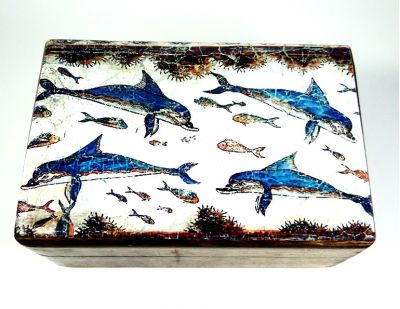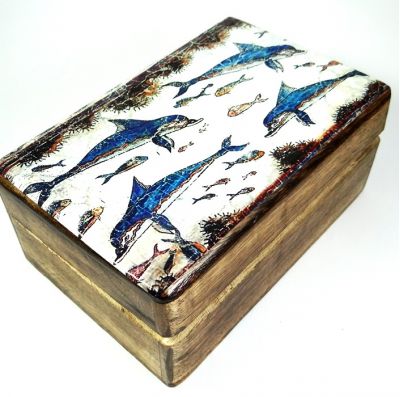The depiction is a detail of the famous fresco of dolphins, which decorated the walls of the queen's room in the palace of Knossos.
It dates back to 1600 BC.
We have created a collection of boxes with themes deriving from Ancient Greece, since the colours and the designs blend with the wood and create a unique gift which can also have a use in the childs room.
Dimentions:15 cm x 10cm x 6cm (height)
All prices include VAT.
The famous fresco of the dolphins decorated the walls of the queen's room in the palace of Knossos on the island of Crete, in Greece. The purpose was to feel very beautiful and calm, every time she wanted to rest. It is dated around 1600 BC. Although few pieces are saved , it is enough to see and admire the art of the dolphins playing with smaller fish in the waves. The Minoans loved the sea and this is clear through their art that created unique works.
The dolphin, was considered as the king of the seas by the ancient Greeks and it was the symbol of Delphinium Apollo and Neptune. As a symbol of the Olympian gods, it had a special place in ancient art, as a decorative motif. There are two dolphins that adorn the lovely mural in "Akrotiri" in Thera. Dolphins were also depicted on vases combined with representations of deities and on ancient coins.
The tridrachms of Delphi, minted around 480-475 B.C., are among the most rare of all the ancient Greek coins. The obverse type of the coin shows two rhyta (drinking vessels) in the form of ram’s heads and above them, two dolphins swimming toward each other. Also, the ancient silver decadrachm (ten-drachma coin) of Syracuse, also known as "Demareteion", which is dated around the 4th century B.C. The coin is a typical example of the Syracuse mint of the classical period. The reverse shows the head of the nymph Arethousa, encircled by four dolphins.
Many writers, poets, musicians and artists in general praised the dolphins. Many myths were referred to dolphins. The most well known myth, is the one of the captivity of Dionysus by Tyrrhenian pirates. As punishment for their crime, Dionysus turned the pirates into dolphins. A relief that depicts the transformation of the pirates into dolphins is rescued at the Choragic Monument of Lysicrates.
The dolphin’s fresco is currently exhibited in the Archaeological Museum of Heraklion in Crete.
No posts found









